|
The Mondragón was a Mexican battle rifle and the world`s first of its kind designed as an automatic rifle. It was designed by Mexican general Manuel Mondragón and became the first automatic rifle specifically designed for the armed forces and put to trial on the battlefield.
Mondragón began his work in 1882 and patented the weapon in 1887. It was gas-operated with a cylinder and piston arrangement, now very familiar but unusual at the time, and rotating bolt, locked by lugs in helical grooves in the receiver; it was also possible to operate it as a simple straight-pull bolt action. The caliber was 7mm (.284 in) Mauser and the rifle was available with either an 8-round or 20-round box magazine, or a 100-round drum magazine (for variants produced after 1910).
swiss replica watches
Features and uses
The Mondragón rifle was known for its stopping power and for being very accurate when used as a semiautomatic firearm but suffered from high recoil and poor accuracy when fired on full automatic. In 1910, a light machine gun variant with a heavier barrel and a redesigned mechanism to improve full automatic accuracy coupled to a 100-round drum was manufactured for the Mexican military. The Mexican Army improved the light machine gun variant of the Mondragón up until 1943, when it was replaced with the Mendoza M-1943 general purpose infantry machine gun.
The first versions of the rifle had trouble working in muddy and moist environments, German troops using the Mondragón rifle in Western Europe had difficulties with the rifle jamming while used in trench warfare. Although they did not function well in the thick moist mud and dirt of Central Europe, they proved to work well in hot and arid climates such as the North of Mexico. This meant the Mondragón did not have a problem with dirt trapped inside, instead having more of a problem with moisture, as it would still work well with dry sand and dust in its mechanism, although the Mexican manufactured models fixed this problem with slight improvements to the firing mechanism and the barrel.
Initial production
Mondragón attempted to interest a U.S. firm, without success as they thought that semi-automatic rifles were not practical and could not be produced in the numbers that Mexico wanted. He then turned to Schweizerische Industrie Gesellschaft (SIG), of Neuhausen am Rheinfall, who agreed to manufacture the rifle. In 1901, the first rifles were shipped to Mexico and issued to the army as the Fusil Mondragón Modelo 1900 with an 8 round magazine.
The Model 1908 has an internal 8-round magazine fed by stripper clips. The Mondragon was never manufactured outside of the SIG factory in Switzerland. Only around 4000 rifles were made and only a few hundred made it to Mexico.
Use in World War I
With World War I, Germany bought the remainder of SIG`s stock that had not been sent to Mexico (which was about 3,000 of the 5,000 rifles), issuing them to the infantry, where they proved highly susceptible to mud and dirt in the trenches (a problem familiar even to less complex bolt action rifles such as the Ross). Instead, realizing their potential as portable yet powerful automatic weapons, they were withdrawn by the German high command and reissued to aircraft crews as the Flieger-Selbstlade-Karabiner Mondragon, Modell 1915 (Pilot`s Selfloading Carbine Model 1915), until enough numbers of machine guns were available. Many of the Mondragon rifles were used with a 30-round helical magazine, known as Trommelmagazin für F.-S.-K.. This helical magazine was patented by Friedrich Blum; the units were tougher than expected. The 32-round drum magazine used by the Artillerie-Modell Pistole 08 (and later by the MP 18) was a direct descendant. Few of the German versions with the helical magazine survive.
Other Mondragon rifles appear to have been used by the navy.
Users
- German Empire
- Mexico
Wars
- Mexican Revolution
- World War I
- World War II
Rifle scheme and operating procedure (Click image to enlarge)
 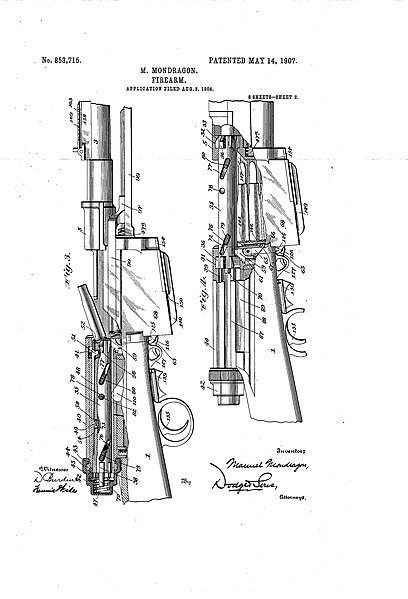 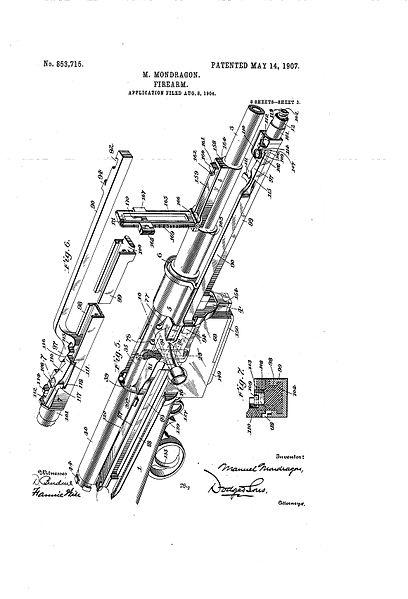 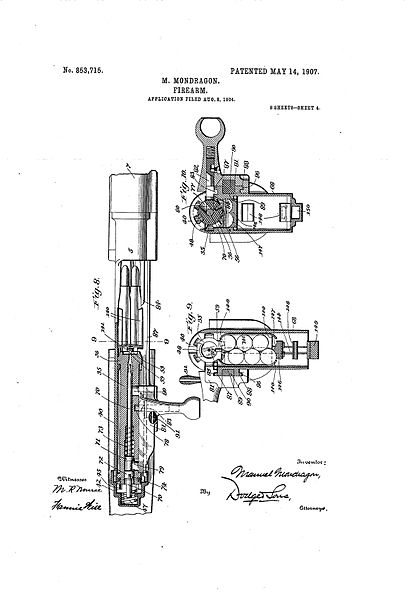
   
 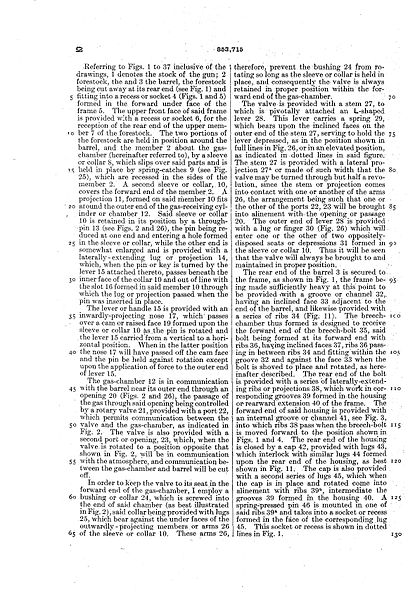   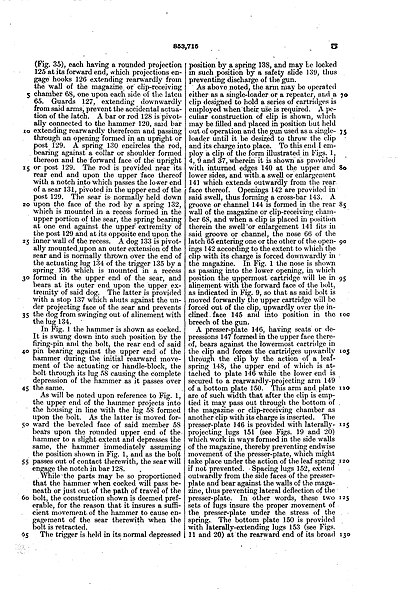   

|
Weapontype:
Battle rifle
Manufacturer:
Schweizerische Industrie Gesellschaft (SIG), Beretta
Operation:
Gas operated, rotating bolt
Cartridge:
7mm Mauser, 7.65×53mm Argentine, 7.5×55mm Swiss, .30-30 Winchester
Weight:
4.18 kilograms (9 lb 3 oz) empty
Length:
1,105 mm (43.5 in)
Magazine Capacity:
8-round box, 10-round box, 20-round box, 30-round drum, 100-round drum
Feed system:
Box or Drum Magazine
In service dates:
1887–1918 (Mexico and Germany)
In Production:
1887
Sights:
Iron
Rate of fire:
750–1400 rounds/min depending on variant
Effective range:
200 m to 550 m sight marks
Muzzle Velocity:
710 m/s (2,300 ft/s)
|

